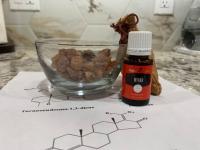April 5, 2023
The early period after tooth extraction is a critical period for wound healing. Wound healing after tooth extraction is considered secondary intention healing. It involves several stages as follows: hemostasis, inflammatory phase, proliferative phase, and finally the remodeling phase.
Wounds usually heal normally unless there is interference by local or systemic factors. In certain circumstances, early wound healing can be enhanced by several interventions such as antibiotics, mouthwashes, or topical medications. Myrrh has been used as a topical medication for promoting wound healing after tooth extraction. It is an aromatic resin exudate obtained from Commiphora molmol and Commiphora myrrh trees, which are species of the Burseraceae family. These species are found in southern Arabia, and from Northeast Africa to Northeast Kenya. Myrrh is chemically composed of about 30–60% of water-soluble gum, 20–40% of alcohol-soluble resin, and 3–8% of volatile oil.
Myrrh has been used as a medicine by Chinese people since the Tang Dynasty in A.D. 60. It has also been used for many years as a medicine in the Middle East Alternative medicine has been well accepted by the public with more than half of the worldwide population using it for treatment. Myrrh, which is used in alternative medicine, was traditionally used for wound care and to treat several diseases including joint pains, gastric problems, infections , sore throats, cough, and burns. It is also used as an oral mouthwash and as anticancer treatment.
40 healthy adult patients were enrolled in this study (20: study group and 20: control group). ). All the activities performed for each group were double-blinded. All the participants underwent dental extraction under local anesthesia using standard protocol. Patients were randomized into two groups. Group A (Test group) consisted of subjects who were prescribed to use Commiphora molmol (myrrh) extract as a mouthwash twice a day for 7 days, beginning from the 1st post-operative day. The required mouthwash amount of 250 ml was made by providing
Group B (Control group) consisted of patients who were prescribed to use saline mouthwash (0.90% w/v of NaCl) twice a day for 7 days beginning from the 1st post-operative day. The researcher prepared unlabeled packs of white nontransparent filter paper, each contains 2.25gm of sodium chloride. Similarly, the patients were instructed to put each pack in a cup of 250 ml warm water for use as a mouthwash.
There was a statistically significant between-group difference in postoperative surgical-site edema, tenderness, and socket size, with the test group showing greater improvements.
Regarding the patients’ symptoms in the control group, it was found that 70% of the participants had no pain, 20% had some degree of pain, and 10% had severe pain. In the experimental group, 95% of the participants had no pain and 5% had some degree of pain.
Thus, these studies show that Myrrh mouthwash has an enhancement effect on wound healing during the early period after tooth extraction.
https://www.ncbi.nlm.nih.gov/pmc/articles/PMC7801243

